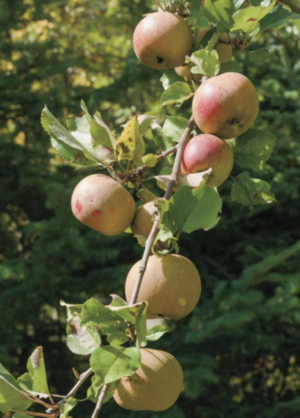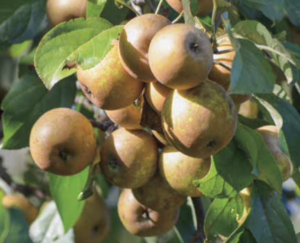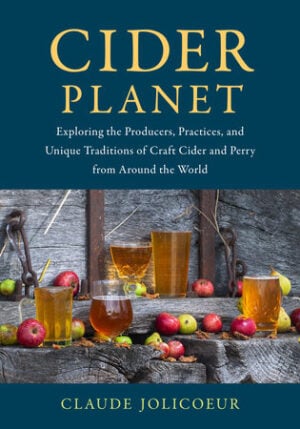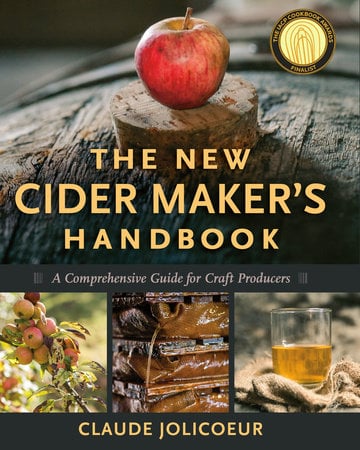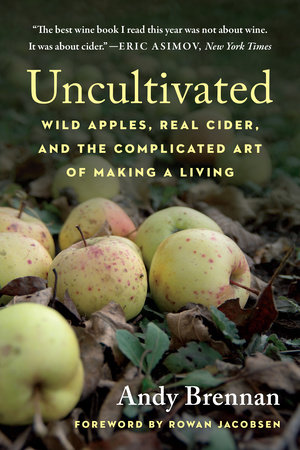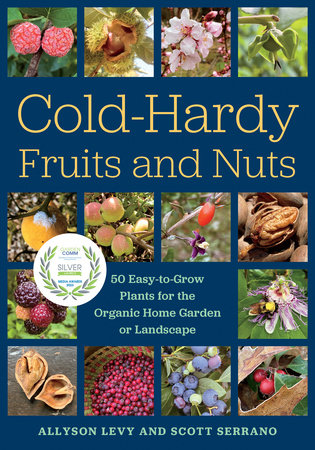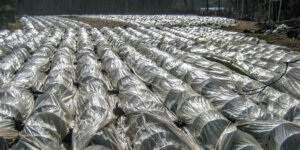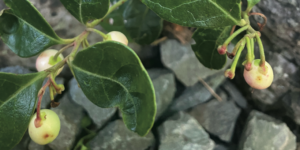The Best Types of Apples for Cider in North America
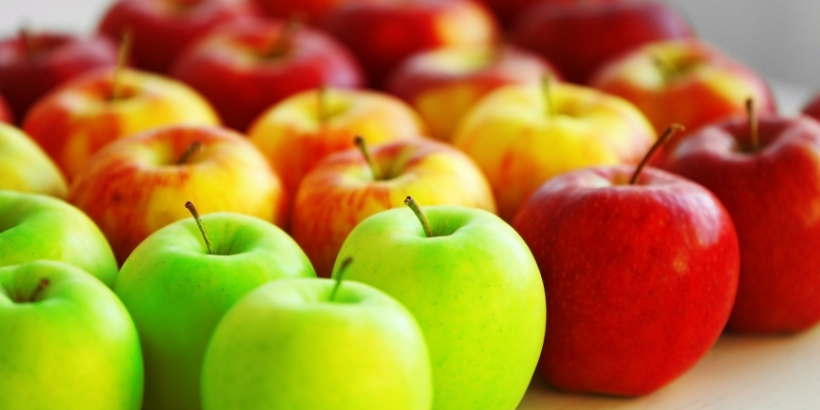
If you’re a fan of cider, you know that the type of apple used can make or break the flavor. And with all the different brands of cider out there, many kinds of apples from across the world are being utilized to create it. In his new book Cider Planet, author and renowned cider maker Claude Jolicoeur discusses the different types of apples for cider to give readers a deeper understanding of everything that goes into a glass of this global delicacy.
But today, we’re focusing on North America. In the excerpt below, Jolicoeur goes over some of the most commonly-used apples for cider in the United States and Canada.
The following is an excerpt from Cider Planet by Claude Jolicoeur. It has been adapted for the web.
Apple Varieties Used for Cider in The U.S. & Canada
The pommages used in North America are very diverse and include commercial dessert varieties, heirloom varieties, and true cider apples. There are great variations among producers, depending on the region and climate, and on the style of cider they produce.
Standard Market Varieties
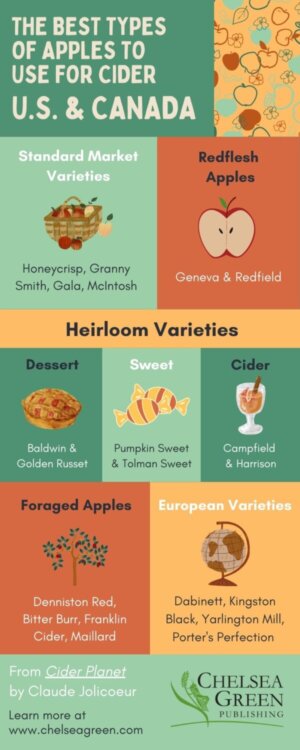
None of these varieties are considered cider apples—they are strictly table, dessert, or cooking apples. When used for cider, they generally provide low to medium acidity and very little tannin. Most would be classified as sharps, while some lower-acidity varieties could be sweets. These apples are generally mass-produced in large intensive orchards that are managed in such a way as to produce good-looking table fruit, and it is the non-premium fruit that is available at low cost and used for cider making.
However, sometimes the same varieties are grown on larger-sized trees with little fertilization in low-spray orchards, and in such cases these apples have improved properties for cider making purposes. An example of this is with Eve’s Cidery in New York, where the Idared is highly prized. And as for myself in Quebec, I use Cortland a lot in my blends. We will not discuss these varieties further, as they are well known. Except for one, however, which I think deserves a special mention.
Goldrush (sharp) is highly prized among many producers of heritage-style ciders, although it is a modern market variety. It gives a lot more substance to the cider than the other varieties of this group. The Goldrush apple was introduced in 1993 as a scab-resistant variety. It is a cross of Golden Delicious and a disease-resistant selection. The apple matures very late; the Golden-type flavor is rich, slightly spiced, with a high sugar content, a good acidity, and more tannins than most dessert apples. This is an apple for districts with a favorable climate with a lot of summer heat and a long growing season.
European Cider Varieties
A number of bittersweet and bittersharp varieties that have been introduced from England, France, and Spain are nowadays under trial in North America. And some of the better-known varieties have been planted by a number of growers for cider production. Most of these varieties had been imported by the 1960s and ’70s and kept in conservation orchards. They are now readily available from a number of nurseries in both countries. It is only very recently, however, that some Spanish varieties went through the US import process, and a few are now available.
According to a document published by Cornell University in 2018, the European cider apples that have the greatest acreage in the State of New York are Dabinett, Kingston Black, Porter’s Perfection, Harry Master’s Jersey, Geneva Tremlett, Brown Snout, Ellis Bitter, Chisel Jersey, Michelin, Brown’s Apple, Yarlington Mill, and Somerset Redstreak.* In the Pacific Northwest, growers tend to have more of the French varieties like Fréquin rouge, Bedan, Binet rouge, Bramtot, Médaille d’or, and Kermerrien. Descriptions for many of these varieties are presented in chapters 2 and 3.
Heirlooms
Heirloom is a word often used for an older apple variety, that is not mass-produced for the market. Generally, we talk about varieties that originated in America, but some were introduced from Europe. Most heirloom varieties fall into one of these broad categories:
- Dessert, table, or cooking apples that are rather sharp and are mainly eaten as fresh fruit and used for pies and cooking.
- Sweet apples that are low in acidity and mostly used for baking or making apple syrup.
- Cider apples that would for most be of the bittersharp, sharp, or bittersweet classes.
Dessert Apples
As for dessert apples, many are still popular as regional varieties, and customers who appreciate them can get them at a pick-your-own farm or at a farmers market. Some were the reigning varieties during their heydays a century or more ago, and have been intensively grown and even exported overseas. (However, at that time the term intensive growing didn’t have the same significance as today because production orchards then consisted exclusively of widely spaced large trees.)
Baldwin originated in Massachusetts as a wild seedling discovered around the 1740s. This old New England favorite was the queen of the orchards until the extreme winter of 1933–1934, when successions of warm and cold killed millions of trees. It was thereafter replaced by the hardier McIntosh as the dominant market variety. It is a heavy bearer, but only in alternate years. The fruit is large and mostly red. It ripens late and keeps well. The juice has good sugar content, and acidity is medium to high. Baldwins have always been used in New England for cider making, and the variety is still highly regarded by some producers. West County Cider makes a fine single-variety cider from Baldwin.
Esopus Spitzenburg is a beautiful medium-sized apple, and it is one of the most flavorful that can be tasted. It is packed with sugar and acidity and gives a lot of punch to a cider blend. But no matter how great its flavor, it never really was grown on a large scale because the tree isn’t very productive and is sensitive to many dis- eases, including fire blight, making it a challenge for the grower. The variety originated at Esopus near the Hudson River in New York, but the date is not documented. It probably originated sometime during the second half of the eighteenth century, as it was known well enough by the early 1800s to be planted at Mon- ticello in Virginia by President Thomas Jefferson, who considered it as one of the best apples. A favorite at Farnum Hill Ciders.
Golden Russet is among the most highly regarded North American apples for making cider. For the writing of The New Cider Maker’s Handbook, I did a survey on the favorite varieties of seven preeminent cider experts in different regions of North America, and the Golden Russet was, by far, the most often mentioned. But its origin is uncertain: It could have been imported from Europe or it could have sprouted as a seedling. In the beginning, it was mostly grown in central and western New York, but it has since conquered the whole continent, proving its great adaptability to diverse conditions, from the mild West Coast all the way to cold Quebec. The strong assets of Golden Russet for making cider are its very high sugar content and its good flavor and aroma, which are combined with a reasonable acidity.
Newtown Pippin, known in Virginia as Albemarle Pippin, is the emblematic variety of one of the oldest cideries in Virginia: Albemarle CiderWorks, owned by the Shelton family. The variety arose as a seedling on Long Island during the first half of the eighteenth century. It became an important variety in the orchards of the Hud- son Valley and also found a favorable ground in Albemarle County, Virginia. About 100 years after its introduction, it could be found successfully growing in some districts on the West Coast. This is a fruit that ripens late and is a great keeper.
Northern Spy appeared in New York State at the beginning of the nineteenth century and remains a favorite with cider makers in that state (mainly in the Hudson Valley and Finger Lakes regions). It is also appreciated in the Great Lakes, the Pacific Northwest, and in the Canadian Maritime provinces. The apples ripen late and keep well, but a fairly long season is required for perfect ripen- ing. The juice has average sugar content and high acidity. It gives a flavor to the cider that can be somewhat peculiar for those who are not accustomed to it. Northern Spy is a favorite at Eve’s Cidery, which makes a highly praised single-variety cider. It is also a favorite of Ryan Burk at Angry Orchard.
Wickson was introduced in 1944 by Albert Etter, who was a plant breeder active in Northern California during the first half of the twentieth century. There is some ambiguity about its genealogy, but according to the plant patent that was filed for it, Wickson is a cross of Newtown Pippin × Spitzenberg Crab.* Wickson is there- fore a fairly modern variety, but it is nevertheless generally considered as being in the heirloom category. It is a beautiful, small red apple, very cold hardy, rich to very rich in sugar and in acidity, with good tannin. Steve Wood of Farnum Hill Ciders was probably the first to grow it at a commercial scale for cider making, and now it is among the 10 most widely grown cider varieties, mostly in New England and in the Pacific Northwest.
We may add to this the Ashmead’s Kernel, an English apple already described in chapter 2. It is well liked among American producers, and a favorite at Black Diamond Cider and at Farnum Hill Ciders. And we could additionally mention Gravenstein, an old classic from Continental Europe introduced to the United States around the end of the 1700s, which found an ideal bioregion in the California’s Sonoma County, where it is a favorite variety for Tilted Shed Ciderworks.
Sweet Apples
The second group is sweet apples. This class of apples was very important for rural people 150 to 200 years ago, as they could boil the juice to make a sweet syrup that served the same purpose as, nowadays, sugar (imported refined sugar wasn’t widely available then). Their low acidity makes them unappealing to eat fresh, as they lack the characteristic freshness of apples, but it made them ideal for making a concentrated syrup that wasn’t overly acidic. In a cider blend these apples mellow the high acidity of the dessert varieties described previ- ously. Sweet apples fell out of favor, however, as sugar became an inexpensive commodity; their cultivation became pointless. Sweet apples of note include the following varieties.
Pumpkin Sweet or Pound Sweet is an old, classic American sweet apple. This is a large green apple that develops a nice yellow color- ing with sometimes a bit of bronze when it’s fully ripened. The variety originated in Connecticut around 1800, and it was first described in 1834. It ripens in late mid-season and doesn’t keep much past December. It is especially esteemed for baking, and there are numerous accounts of it being used for cider making. It makes a thick syrupy juice, very sweet, and slightly astringent. Cidrerie Michel Jodoin in Quebec grows it, and Michel, being quite fond of it, is planning to plant more.
Tolman Sweet is a variety of uncertain origin, but some authors have speculated that it appeared in Massachusetts before 1800 because it was described in 1822 by James Thacher in The American Orchardist. In 1905, S. A. Beach wrote in The Apples of New York that it “has gained the reputation of being one of the hardiest of the old New England varieties.” This is a medium-size, mostly green- ish-yellow apple that ripens late and keeps well. The flesh is, however, quite peculiar, completely lacking acidity. Some astrin- gency is readily noticeable when eaten, and there is a long persistency of the flavor, thus indicating a non-negligible amount of tannins. For my part, by tasting it I think it could be classified as borderline between sweet and bittersweet. However, I haven’t as yet seen results of juice analysis, which could confirm this impression.
There were at one time quite a number of other varieties in this class of sweet apples. Just the name Pumpkin Sweet may refer to two or three other varieties of large sweet apples. We may additionally add the Sweet Bough, which has also been used for cider, but being more of a summer apple, it matures too early to be really useful.
Cider Apples
The third group of heirloom varieties is for true cider apples, varieties of American origin that were mainly used for cider making during the heydays of US cider production in the seventeenth to nineteenth centuries. Most varieties of the past are now lost, unfortunately, but a few have been rediscovered in old orchards and identified by apple experts. I wish to highlight here the important role played by Tom Burford for the identification and propagation of some of these varieties, in particular the Harrison and the Hewe’s Virginia Crab. Without him these apples would not have the dis- semination they now have. Burford came from a family of Virginia farmers, operated a nursery for many years, and is the author of a number of publications, among which is his Apples of North America (2013). He has worked closely with pioneer cider makers in Virginia (Diane Flynt of Foggy Ridge Cider, and Chuck and Charlotte Shelton of Albemarle CiderWorks) to make sure these apples would not be lost a second time, and he tirelessly sent free scion wood to all who showed interest in these varieties.
Campfield (bittersweet) and Graniwinkle (sweet) are two varieties that have a somewhat comparable story. They were used a lot by New Jersey cider makers during the 1800s. I haven’t been able to find information on how these varieties have gone through the twentieth century and how they reappeared on the modern cider scene, but nowadays we see them here and there in the catalogs of a few specialized nurseries. As far as I know they haven’t yet been planted on a large scale, but they have been tested at Washington State University where the measured properties would classify Campfield as a bittersweet, and Graniwinkle as a sweet.
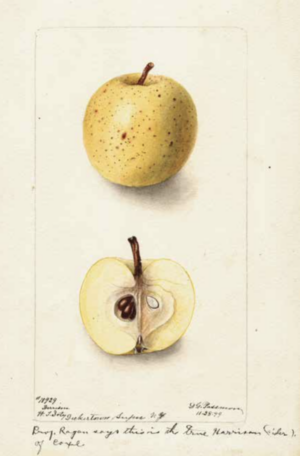
A watercolor representation of a Harrison apple from the US Department of Agriculture (USDA) Pomological Watercolor Collection, dated 1899, and identified by the eminent pomologist W. H. Ragan as the true Harrison of Coxe.
Harrison (sharp to bittersharp) was the reigning cider apple variety two-hundred years ago in the eastern counties of New Jersey, which were then among the most important cider production regions on the continent. All conditions were met for the development of this industry: a good terroir and the proximity of the important market that was New York City. The Harrison apple appeared in the region of Newark in the early 1700s. It could be used as a single variety or blended with sweeter varieties such as those mentioned previously. However, as cider declined in the second half of the nineteenth century, the Harrison apple wasn’t planted anymore and slowly sank into oblivion. The variety was long thought to be lost until the mid- 1970s when an old tree standing by an ancient cider mill in New Jersey was identified as a Harrison. Cuttings were taken. Some time later, under the influence of Tom Burford, it is in Virginia that the Harrison made its first real comeback, more specifically in the orchards of Foggy Ridge Cider and Albemarle CiderWorks. They were the first to commercially make cider with it. Nowadays, important blocks of Harrison are being planted in all cider districts of the continent, and many cider makers are starting to use it as the trees grow older and the production increases. Analysis results of the juice show very high sugar content with medium to high acidity and low to medium tannin.
Hewe’s Virginia Crab (bittersharp) may have its origin in Virginia in the beginning of the eighteenth century. This apple also has been grown in the Canadian Prairies, where it has shown great winter hardiness. Some authors suspect it could have the indigenous crab species, Malus angustifolia, as an ancestor. Whatever its true origin and genealogy, we have many accounts of this apple being the most widely grown variety in Virginia for cider during the late 1700s and early 1800s, and that President Thomas Jefferson was very fond of it, and of the crab cider his people made for him in Monticello. The juice of the Hewe’s Virginia Crab has a high content of sugar, high to very high acidity, and medium tannin that is rather soft and astringent. It’s a favorite at Albemarle CiderWorks for making a fine single-variety cider.
In addition to the varieties noted here, I will mention two other old cider varieties that may still be found in some nursery catalogs, but for which very little information is available: Smith’s Cider, a variety that would be borderline between sweet and mildly sharp that is from Pennsylvania; and Taliaferro, a quite obscure and almost mythical sharp or bittersharp variety that is said to have been cultivated by President Thomas Jefferson at Monticello.
Redflesh Apples
The use of redflesh apples to make ciders that keep a rosé or bronze color started in North America relatively recently. At least two importations of pink or redflesh apples in the United States are documented. The first is with a pink-fleshed variety of unknown origin that had spread in Western Europe and was called the “Surprise apple” in England around 1830, and subsequently brought into the United States, most likely by German immigrants. After introductions, many red-flesh varieties were bred, but those varieties that inherited the redflesh trait from the Surprise apple do not show as deep of a red juice as those that come from M. niedzwetzkyana. In cider making, two of the most often used redflesh varieties are the Redfield and the Geneva.
Geneva (bittersharp) was bred in Canada at the Ottawa Central Experimental Farm and introduced in 1928, within a program that was aimed at the development of decorative crabapple variet- ies with pink or red flowers, using M. niedzwetzkyana as the seed parent. It was first used for cider making purposes during the 1970s by Cidrobec, a company in Rougemont, Quebec, that produced industrial ciders. But that effort didn’t last for very long. The juice of Geneva is of a beautiful red color, is relatively low in sugar content, medium to high in acidity, and quite astringent.
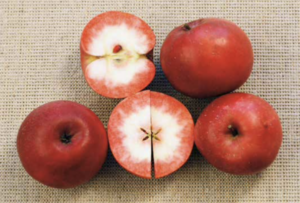
Redfield apples grown in the orchard of West County Cider.
Redfield (bittersharp) is a large apple obtained from a cross of Wolf River × M. niedzwetzkyana, and it was introduced in 1938 by the New York State Agricultural Experiment Station in Geneva. The variety wasn’t successful at first, because its taste as fresh fruit isn’t very good. But it bakes well and the tree is great: beautiful and healthy, with bronze-red leaves and pink blossoms. The cider produced by West County Cider with the Redfield has a beautiful copper-rose color, a very pleasant red berry aroma, a nice, slightly astringent and persistent mouthfeel, and a very good acidity–tannin balance with medium-dry sweetness.
Foraged Apples
In recent years, a number of cider makers have searched the woods, roadsides, and abandoned orchards for apples suitable for cider making. Such apples are often called “foraged” or “wild” apples. Generally unnamed, they are either natural seedlings or rootstocks that have survived or outgrown a grafted tree, or they may be a grafted variety whose identity has been lost. Foraged apples are usually quite rich in tannins. Most are also rich in acid and would be classified as bittersharps; but occasionally some are found that may be classified as bittersweets.
Some of the foraged apples have been found to have really superior qualities year after year, and they have been named by their respective discoverer. This effort has the objective to develop a native pommage, a collection of varieties that may eventually replace the European varieties used by many producers to provide the tannins required for a great heritage-style cider. In effect, the use of European varieties may be seen as a transitional period before the advent of native varieties that no doubt will have many advantages. First, these local varieties have a good chance of being better adapted to the terroir. And, second, their flavor will be different from that of the imported varieties and, with time, this will permit the development of true North American pommages and cider styles. Following are a few foraged apple varieties that have been named by their respective dis- coverers. Note that this list is far from being exhaustive—it simply exemplifies the work that has been accomplished so far.
Andy Brennan of Aaron Burr Cider in the Hudson Valley, New York, is one of the better-known cider makers who use foraged apples. His ciders are highly praised and he has contributed a lot in increasing the popularity of foraged apples in cider making. He estimates that he has tried approximately 400 different apples that he found in all the locations he forages. Of these, he grafted about 100 in his orchard for further evaluation. He has named the following varieties.
Denniston Red (bittersharp) was brought to his attention in 2013 by the owner of the property where the tree grows. It has medium sugar, medium acid, and high tannin content. The apple is medium size, round, deep red with some green where in shade. The season is mid to late. The tree has shown some resistance to fire blight and to rust, and is apparently a regular bearer.
Bitter Burr (bittersweet) unexpectedly grew on Brennan’s property from the rootstock of a tree when the grafted part died. It bore its first fruits in 2015. The apple is yellow, tannic, and low in acid. The flavor is somewhat similar to some bitter cider apples in France.
Bill Mayo is an orchardist in Franklin County, Vermont. He dis- covered a prolific seedling tree growing wild on his property. Mayo isn’t a cider maker, but he had the intuition it could do well for that purpose, and he gave some apples to cider makers he knew so they could test the apple in their blends. After getting some positive comments about the apple, he went through the process of making it a named variety:
Franklin Cider (bittersharp) was discovered by Mayo in 2008. Reports indicate it to be extremely productive, with the juice hav- ing high sugar, acidity, and tannin contents. The variety has been patented and is now distributed by Stark Bro’s Nurseries & Orchards Co. It was officially introduced in 2017 under the name Stark Franklin Cider. This is the first among the newly discovered or foraged varieties to be propagated at such a large scale and to be made available for general planting.
Eric Shatt runs Redbyrd Orchard Cider in the Finger Lakes, New York. Eric is an accomplished orchardist who also manages the experimental orchards of Cornell University at Ithaca. Here is one variety among his finds:
Gnarled Chapman (bittersweet) is a late variety and was introduced in 2015. It is now offered by the Fedco Trees nursery, with the fol- lowing description in their catalogue: “Large, roundish-oblate and outrageously beautiful. Yellowy-green skin with a glowing orange blush, netted and dotted with russet. Eric named this seedling in honor of America’s most famous apple guy, John ‘Appleseed’ Chapman. Vigorous upright tip-bearing tree. Recommended for trial in all cider-apple growing districts. Blooms midseason. Zone 4–7.”
And as for myself, in Charlevoix County, Quebec, Canada, I’ve found quite a few apples that appear to have a good potential, among which I have named the Banane amère, Bilodeau, Douce de Charlevoix, and Maillard, which are now available from a few specialized nurseries in North America, and are undergoing formal testing in standard orchard conditions by RECUPOM in Frelighsburg (Quebec). There is also a number of still-unnamed varieties that I am evaluating. Mean-while, here is a description of my favorite named variety.
Douce de Charlevoix (bittersweet) is an early midseason apple that blends very well with other apples that ripen by mid-September for the making of first season cider. This variety has a good potential for marginal regions with cold winters and short summers. It has become my own emblematic variety, and I use it at up to 60 percent in blends (not more because some juice with higher acidity is needed for balance). It gives a very fragrant aroma to the cider.
There are many more native varieties from cider makers in all parts of the continent. In fact, millions of naturally occurring seedling apple trees are in North America. Each of them is unique, following the laws of genetics. And although only a small fraction of them have the potential to become a good cider variety, this small fraction nevertheless represents a great number of potentially excellent apples that go unnoticed and whose fruit at present only feeds wild animals. Naturally, only time will tell if any of the varieties noted here will become important enough to be grown at a commercial scale. It should be noted that most are still not available from nurseries and can only be obtained as scion wood from their respective discoverer. There is also a need for lots of testing in real orchard conditions. Those that successfully pass this test period will be propagated by nurseries, to be eventually distributed to apple growers.
Recommended Reads
Recent Articles
Want to grow year-round, but a greenhouse feels like a big investment? When it comes to cost and flexibility, low tunnels are the all-around winners.
Read MoreWintergreen is the stunning evergreen groundcover that’s a game-changer for your garden! It’s cherished for its aromatic leaves, vibrant fall color & bright berries.
Read MoreGrow winter carrots for a sweeter & more flavorful harvest! Ditch the bland, store-bought carrots this winter! Grow your own winter carrots for a sweeter and more flavorful twist 🥕🥕
Read More

